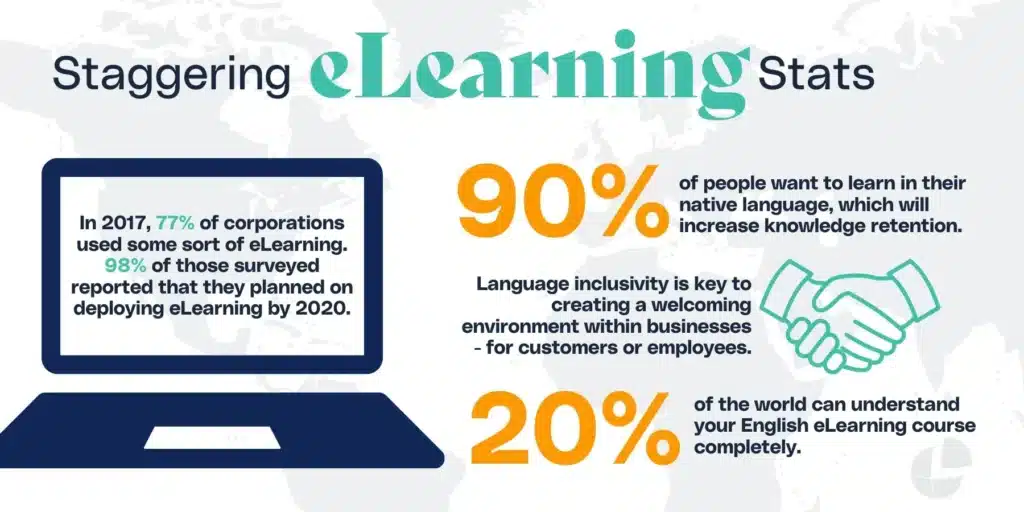
Learn how eLearning translation enhances accessibility and relevance for global audiences, the importance of this process given the widespread international popularity of eLearning, and the detailed steps involved in ensuring both cultural and linguistic accuracy in translated courses.
Today’s digital age has done more than change the way we communicate, socialize, and conduct business. It has also significantly impacted the way we learn. Online learning, often called “eLearning,” is becoming a popular alternative to traditional in-class instruction due to its accessibility, effectiveness, and scalability.
As effective as eLearning is, presenting material in one language (like English) is a mistake. You may fail to reach a significant percentage of your audience. This is why eLearning translation is a vital component of a successful online course.
Topics covered in this article:
- What is eLearning translation?
- Why is eLearning translation important?
- Benefits of eLearning Translation
- eLearning is Popular Internationally
- How are translated eLearning courses developed?
- How does eLearning translation work?
- Continue Learning about eLearning Translation
What is eLearning Translation?
eLearning translation is the process of converting online educational content from one language to another. eLearning localization takes translation a step further by adapting the content to the target audience’s preferences.
Localization does more than simply translate words. It ensures that cultural nuances are taken into account, visuals are appropriate, and all content is understood in context by your target audience.
This involves translating text, audio, and multimedia elements to make the course accessible to speakers of the target language, while often incorporating cultural adaptations to ensure the material is relevant and engaging for the new audience.
Think of it as an online classroom for schools and places of higher education. However, eLearning actually is utilized across many industries: education, manufacturing, associations, nonprofit organizations, the medical field, and more. Online courses make it easy to educate others, train a global workforce, and provide resources to people around the world.
Why is eLearning translation important?
eLearning translation can increase your audience reach and help the learner retain more of the information from the course.
eLearning is only effective if the audience can understand what is being said. If you are a company or organization with a multilingual audience, eLearning translation is a must. The course content needs to be delivered in the language that your audience best understands. An accurate and culturally appropriate translation is the key to facilitating understanding and retention of the material.
When people are presented with content in their native language, it creates an inclusive and welcoming environment. Statistics show that 90% of people prefer learning in their native language. By giving your learners a course that they can understand, you show that you care. When creating your course, it’s important to follow some best practices that make eLearning translation straightforward.
Benefits of eLearning Translation
There is a wealth of benefits associated with eLearning, both for students and for the organizations providing the courses. A few advantages include:
1. Accessibility & Wider Audience Reach
Coordinating in-class training times can be problematic for businesses. Accommodating everyone’s schedule is nearly impossible and cuts into valuable time for teams. The fix is eLearning courses that are available on-demand and can be taken at any time. People can conveniently learn at their own pace and in their own language when it best fits into their schedule.
Thanks to the services of professional translation companies, eLearning translation is easy. By working with a professional agency, you can translate your course into any language. This means that not only can these courses be accessed anywhere in the world, but they can also reach anyone, regardless of the language spoken.
2. Increased Learning Retention, Comprehension, and Engagement
According to the Research Institute of America, eLearning information retention rates range between 25% -60%. But that is when learning in your native langauge. eLearning translation allows the reader to learn in their native language at their own pace. Studies show that learning in their native language will retain more of the information. This creates consistency in organizations and prevents variations that can occur between different instructors and in-person learning settings.
Plus, localized content is more relatable and engaging for learners, which can lead to better retention and completion rates.
3. Scalability & Cost Effectiveness
Localizing your eLearning courses is a smart financial decision for businesses to get a quick return on investment for their employees’ education. You don’t have to have an instructor in every language if you offer translated eLearning courses. Plus, digital-based learning courses typically require 40%-60% less employee time compared to traditional settings. eLearning is also scalable, meaning a company can easily provide a course to 10 people or 1,000 people.
Again, this increases consistency no matter the employee’s demographics or decent, bringing us back to accessibility and equality for all staff.
eLearning is Popular Internationally
eLearning use has been on the rise for years, and experts say it shows no signs of slowing down. In fact, studies predict that by 2025, the online international learning market will be worth $325 billion— a 300% increase from 2015 levels. In 2017, approximately 77% of corporations in the United States utilized some form of online learning, and 98% of those surveyed reported that they planned to deploy it by 2020.
In the midst of the COVID-19 pandemic, eLearning has become a necessity for many globally. The industry has been at the forefront as schools and companies come up with work-from-home solutions. Thanks to the quick ramping up and preparation of eLearning companies, so many have been able to take advantage of what online learning has to offer during this time of crisis.
How are translated eLearning courses developed?
If you’re choosing a good translation company, translated eLearning courses are developed in the exact same files and formats as your English courses: video, narrated slideshows, quizzes, surveys, and games, just to name a few. A good translation agency can work with any of the eLearning authoring tools available on the market that allow instructors to create their own courses, including:
- Storyline 360
- Storyline 3
- Articulate Rise
- Adobe Captivate
- Internally-developed web-based tools
Additionally, editing software such as Vyond and Adobe Premiere can also be used to create video content, which can be included as part of your training.
Have a custom built platform that hosts your eLearning materials? You can translate Learning Management Systems (LMS) too.
How does eLearning translation work?
The process for eLearning translation differs from course to course. For example, the workflow for a Storyline translation may differ from that of a course created with Adobe Premiere. But, generally speaking, your eLearning translation may involve a combination of the following:
1. eLearning Localization Project Preparation
After analyzing your files or cloud-based content, Interpro’s experts ensure that any issues are resolved prior to starting the translation and localization process. All translation projects begin with these steps:
- Project timeline is established with clear deliverables and delivery dates. Translation projects in multiple languages can be launched simultaneously.
- Source files are prepared for translation using Translation Memory tools; filters are employed to protect coding and tags surrounding source language content; formula functions are excluded and protected.
2. Text Translation and Localization
All eLearning translation begins with the course script being translated by our professional linguists
. However, this goes beyond what might appear in course videos. Graphics, buttons, interactive components like quizzes and games, and additional resources should also be translated, correctly formatted, and seamlessly integrated into the course. Even the website or landing page the course lives on and any linked documents will need to be translated as well – think about items study guides, reference materials, and instruction documents.
In general, an eLearning course will follow these steps:
- Course script is translated by our professional linguists
- Our professional linguistic teams execute the Translation, Revision and Proofreading (TRP) phases
- Script is then submitted for review and approval by the client before voiceover recording takes place
3. Audio Recording and Syncing
Most all eLearning translation processes include translating video, either through voice-over narration, or subtitles. To effectively translate these, audio must be transcribed, translated, re-recorded (or written in the case of subtitles) in the target language, and then synced into the course. In each of these steps, accuracy is crucial for a good eLearning translation. Recording should be done in a professional studio setting by a native-speaking talent in order to ensure quality. After recording, the audio needs to be synced into the course in a way that makes sense to the user.
- Pronunciation guidelines and any other instructions for recording are reviewed
- Script is professionally recorded and subtitled
- Text-to-speech and synthetic VOR solution options available
- Audio and text are synchronized with video
- Onscreen interactions are synchronized with target language voiceover
3. Final Delivery and Quality Assurance
After a course is translated, it should undergo comprehensive Quality Assurance by a native speaker of the target language in order to ensure the entire course and all of its components are fully and correctly translated.
- Localized course is validated, including knowledge checks, assessments, and quizzes
- Final course is published per specific publication settings
- The translated files are delivered ready for publication via the platform established at project launch
Look for a translation agency that can offer certified translations or holds ISO certifications for the best guaruntee of an accurately translated product and quality customer service.
Because of its adaptability, effectiveness, and scalability, eLearning has quickly become the most widespread way to educate and train your workforce, students, and organization members. If operating within a multilingual organization, eLearning translation is key to ensuring that all participants can effectively learn and understand the material. Teaming up with a professional translation company capable of handling all aspects of eLearning translation and localization will ensure success for your organization, no matter the course topic or language.
Category: Translation
Tags: ELearning translation, Elearning, Elearning Content, Elearning localization
Service: eLearning Translation
Industry: Education, Learning and Development
Don't forget to share this post!
Stay Updated with Interpro
Subscribe to our newsletter for the latest updates and insights in translation and localization.










